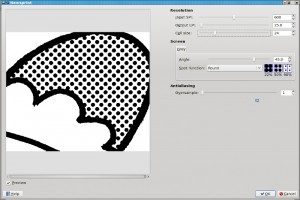There are lots of graphics software applications out there. Photoshop is the big dog on the block and many professional artists, cartoonists, and film makers use it for a variety of tasks. There are also graphics applications that rival Photoshop and do just about as much as Photoshop but a t a lower cost. It all depends on the job you’re tackling and how many digital tools you require.
I’ve found that The Gimp does just about all I need when producing my comic features. And the costs is much less than Photoshop. Gimp is free. And because I use Linux, The Gimp already comes pre-installed. When you install Linux, Gimp is right there ready to go to work for you.
Gimp has all the neat little filters, bells, and whistles that all the other graphics software apps have. I use ’em all, but one filter, specifically, comes in quite handy when drawing cartoons.
It’s called “Newsprint.” The Newsprint filter will convert a gray area in a pattern of dots or lines to line art. it’s similar to the Zipatone used by many a cartoonist years go.
Zipatone was a sheet of plastic that had a pattern of lines or dots printed on it. It had an adhesive back. If you wanted to add a gray shaded area to your cartoon, you’d cut out a large swatch of Zipatone, lay it down over the area of the cartoon, then pull out your Exacto knife and cut and trim around the shape that needed shading. It was a pretty long process. Now, the Gimp does it in a few clicks.
Get the Gimp and I’ll show you how. You can download Gimp from their web site. (If you run Linux, no need to download and install. It’s already on your system. You’re good to go.)
First, open your cartoon. Make sure it’s a grayscale image. You can do this by selecting Image>Mode>Grayscale from the menu. Next, find the area you want to use the Newsprint effect on. Using the bucket or brush tool, fill that area with a shade of gray. You can see how I’ve done mine in the image at top left. this is a cartoon drawing I’m using for my Word Pile cartoon game panel.
Next, use the Wand select tool and select the area of gray you want to use the Newsprint effect on. (I use the wand tool if I want to convert more than one area on the same cartoon drawing with different patterns. Otherwise, you can just go straight to the filter.) You should now have the “marching ants” line around the area you want to convert.
Now, simply go to the menu and select Filters>Distorts>Newsprint. a new window comes up with a real time preview screen. Play with the sliders to control the size, shape and angle of the line or dot you want to lay in.
Click OK and Gimp does the rest!
You can see the completed effect at left. Just by using the bucket fill tool, filing an area with gray, and then using the newsprint tool, I’ve saved myself a lot of time! I don’t need to draw a lot of shading lines and dots. Gimp does it for me! Plus, if I don’t like it, I can always go back and change it with a click of the mouse.
Do you have a creative, aspiring cartoonist in your family? Then get Linux and get the Gimp! Gimp is powerful and feature rich and FREE! Plus, Linux is much more stable and secure than Windows. And Linux is immune to Windows viruses, Trojans and spyware.
Linux and Gimp. I use them both in my studio.






GIMP doesn’t *always* come pre-installed with GNU/Linux. Many distros install it for you, but some don’t. Fortunately, it’s almost always available in the repositories.
Good article. One correction though, several distros of Linux to not come with Gimp pre-installed. Ubuntu is one in which you have to install it specifically from the repositories.
Wolf & Ben,
Thanks for the nice comments.
And thanks for the update on Gimp’s availability. I stand corrected.:) Gimp pre-installed or available in the repositories is what make Linux so terrific! So many different approaches.:)
It’s been a while since I ran Ubuntu. Similarly, PCLinxOS does not have OpenOffice pre-installed, but rather a “Get OpenOffice” desktop icon. Once clicked it takes you to the repository, downloads ,and installs OO.
Perhaps distros should have something like this for Gimp.